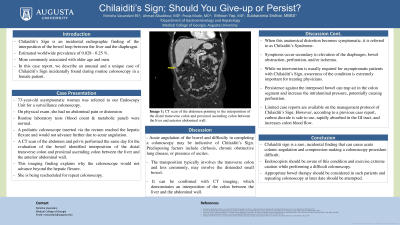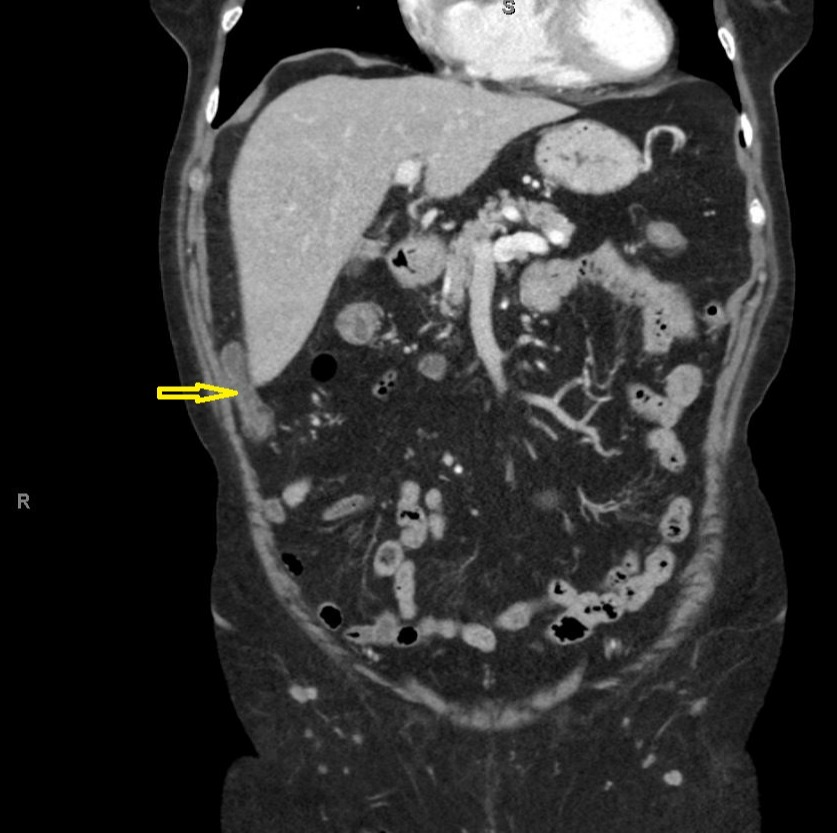Back


Poster Session A - Sunday Afternoon
Category: General Endoscopy
A0278 - Chilaiditi’s Sign: Should You Give Up or Persist?
Sunday, October 23, 2022
5:00 PM – 7:00 PM ET
Location: Crown Ballroom

Has Audio

Nimisha Vasandani
Medical College of Georgia
Augusta, GA
Presenting Author(s)
Nimisha Vasandani, 1, Ahmad Alkaddour, MD1, Pooja Mude, DO2, John Erikson L. Yap, MD2, Subbaramiah Sridhar, MBBS, MPH1
1Medical College of Georgia, Augusta, GA; 2Augusta University Medical College of Georiga, Augusta, GA
Introduction: Chilaiditi’s sign is an incidental radiographic finding of the interposition of the bowel loop between the liver and the diaphragm. With an estimated worldwide prevalence of 0.028 - 0.25 %, this is commonly associated with older age and men. Below, we describe an unusual case of Chilaiditi’s sign incidentally found during a routine colonoscopy in a female patient
Case Description/Methods: A 73-year-old asymptomatic woman was referred to the Endoscopy Unit for a surveillance colonoscopy. On physical examination, the patient had no abdominal pain or distension. CBC and CMP were unremarkable. Pediatric colonoscope was inserted via the rectum and reached the hepatic flexure. However, due to an acute angulation, the scope was not able to be advanced further and the procedure was therefore aborted prematurely. A CT scan of the abdomen and pelvis performed the same day identified interposition of the distal transverse colon and proximal ascending colon between the liver and the anterior abdominal wall, which explained the difficulty encountered in advancing the colonoscope beyond the hepatic flexure. She is being rescheduled for repeat colonoscopy.
Discussion: Acute angulation of the bowel and technical difficulty in completing a colonoscopy may be indicative of Chilaiditi’s sign. Predisposing factors include: cirrhosis, COPD, or presence of ascites. When this anatomical distortion becomes symptomatic, it is referred to as Chilaiditi’s syndrome. These symptoms are secondary to elevation of the diaphragm and/or bowel obstruction, perforation, or ischemia. It can be confirmed with CT imaging, which typically demonstrates an interposition of the transverse colon between the liver and the abdominal wall. While no intervention is usually required for asymptomatic patients with Chilaiditi’s sign, awareness of the condition is important for physicians. Forceful pressure against the interposed bowel can trap air in the colon segment and increase intra-luminal pressure, potentially causing perforation. To decrease the risk of perforation, carbon dioxide can be administered in patients with known Chilaiditi’ sign during colonoscopy as an insufflating agent. Limited case reports are available on the management protocol for patients with Chilaiditi’s sign; however, according to a previous case report, carbon dioxide is safe and effective in the GI tract. It is imperative that endoscopists are aware of this condition and exercise extreme caution while performing a difficult colonoscopy.

Disclosures:
Nimisha Vasandani, 1, Ahmad Alkaddour, MD1, Pooja Mude, DO2, John Erikson L. Yap, MD2, Subbaramiah Sridhar, MBBS, MPH1. A0278 - Chilaiditi’s Sign: Should You Give Up or Persist?, ACG 2022 Annual Scientific Meeting Abstracts. Charlotte, NC: American College of Gastroenterology.
1Medical College of Georgia, Augusta, GA; 2Augusta University Medical College of Georiga, Augusta, GA
Introduction: Chilaiditi’s sign is an incidental radiographic finding of the interposition of the bowel loop between the liver and the diaphragm. With an estimated worldwide prevalence of 0.028 - 0.25 %, this is commonly associated with older age and men. Below, we describe an unusual case of Chilaiditi’s sign incidentally found during a routine colonoscopy in a female patient
Case Description/Methods: A 73-year-old asymptomatic woman was referred to the Endoscopy Unit for a surveillance colonoscopy. On physical examination, the patient had no abdominal pain or distension. CBC and CMP were unremarkable. Pediatric colonoscope was inserted via the rectum and reached the hepatic flexure. However, due to an acute angulation, the scope was not able to be advanced further and the procedure was therefore aborted prematurely. A CT scan of the abdomen and pelvis performed the same day identified interposition of the distal transverse colon and proximal ascending colon between the liver and the anterior abdominal wall, which explained the difficulty encountered in advancing the colonoscope beyond the hepatic flexure. She is being rescheduled for repeat colonoscopy.
Discussion: Acute angulation of the bowel and technical difficulty in completing a colonoscopy may be indicative of Chilaiditi’s sign. Predisposing factors include: cirrhosis, COPD, or presence of ascites. When this anatomical distortion becomes symptomatic, it is referred to as Chilaiditi’s syndrome. These symptoms are secondary to elevation of the diaphragm and/or bowel obstruction, perforation, or ischemia. It can be confirmed with CT imaging, which typically demonstrates an interposition of the transverse colon between the liver and the abdominal wall. While no intervention is usually required for asymptomatic patients with Chilaiditi’s sign, awareness of the condition is important for physicians. Forceful pressure against the interposed bowel can trap air in the colon segment and increase intra-luminal pressure, potentially causing perforation. To decrease the risk of perforation, carbon dioxide can be administered in patients with known Chilaiditi’ sign during colonoscopy as an insufflating agent. Limited case reports are available on the management protocol for patients with Chilaiditi’s sign; however, according to a previous case report, carbon dioxide is safe and effective in the GI tract. It is imperative that endoscopists are aware of this condition and exercise extreme caution while performing a difficult colonoscopy.

Figure: CT Scan of abdomen showing the interposition of the distal transverse colon and proximal ascending colon between the liver and the anterior abdominal wall.
Disclosures:
Nimisha Vasandani indicated no relevant financial relationships.
Ahmad Alkaddour indicated no relevant financial relationships.
Pooja Mude indicated no relevant financial relationships.
John Erikson Yap indicated no relevant financial relationships.
Subbaramiah Sridhar indicated no relevant financial relationships.
Nimisha Vasandani, 1, Ahmad Alkaddour, MD1, Pooja Mude, DO2, John Erikson L. Yap, MD2, Subbaramiah Sridhar, MBBS, MPH1. A0278 - Chilaiditi’s Sign: Should You Give Up or Persist?, ACG 2022 Annual Scientific Meeting Abstracts. Charlotte, NC: American College of Gastroenterology.

